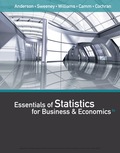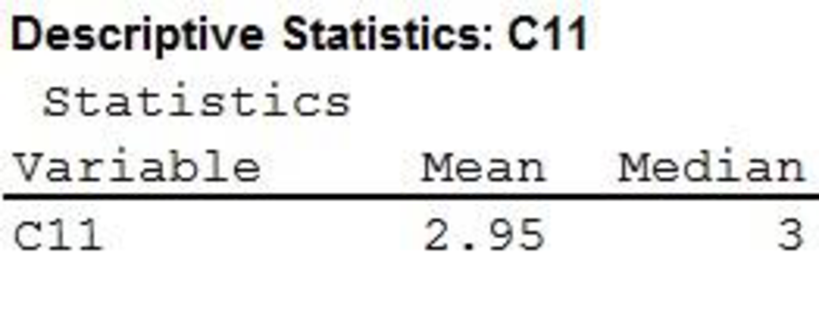
Concept explainers
a.
Find the
a.
Answer to Problem 62SE
The mean and median are 2.95 and 3, respectively.
Explanation of Solution
Calculation:
The data represent the number of times a sample of 20 families dined out in the previous week.
Store the variable, “Number of times the families dined outside in the previous week” in Column C11 of a MINITAB worksheet.
Mean and Median:
Software Procedure:
Step-by-step procedure to obtain the mean and median using MINITAB software:
- Choose Stat > Basic Statistics > Display
Descriptive Statistics . - In Variables enter the columns C11.
- In Statistics select Mean and Median.
- Click OK.
The output obtained using MINITAB software is given below:

Thus, mean and median are 2.95 and 3, respectively.
b.
Find the first
b.
Answer to Problem 62SE
The first quartile is 1 and the third quartile is 4.75.
Explanation of Solution
Calculation:
First quartile and Third quartile:
Software Procedure:
Step-by-step procedure to obtain the first and third quartiles using MINITAB software:
- Choose Stat > Basic Statistics > Display Descriptive Statistics.
- In Variables enter the columns C11.
- In Statistics select First quartile and Third quartile.
- Click OK.
The output obtained using MINITAB software is given below:

Thus, the first and third quartiles are 1 and 4.75, respectively.
c.
Find the
c.
Answer to Problem 62SE
The range and interquartile range are 7 and 3.75, respectively.
Explanation of Solution
Calculation:
Range, and Interquartile range:
Software Procedure:
Step-by-step procedure to obtain the range and interquartile range using the MINITAB software:
- Choose Stat > Basic Statistics >Display Descriptive Statistics.
- Click OK.
- In Variables, enter the column of C11.
- In Statistics select Range and Interquartile range.
- Click OK.
The output obtained using MINITAB software is given below:

Thus, the range of the data is 7 and the interquartile range is 3.75.
d.
Find the variance and standard deviation.
d.
Answer to Problem 62SE
The variance and standard deviation are 4.366 and 2.089, respectively.
Explanation of Solution
Calculation:
Software Procedure:
Step-by-step procedure to obtain the variance and standard deviation using MINITAB software:
- Choose Stat > Basic Statistics >Display Descriptive Statistics.
- Click OK.
- In Variables, enter the column of C11.
- In Statistics select Variance and Standard deviation.
- Click OK.
The output obtained using MINITAB software is given below:

Thus, the variance of the data is 4.366 and the standard deviation is 2.089.
e.
Explain about the shape of the distribution and also explain the reason for the expected shape.
e.
Explanation of Solution
The given information is that the skewness measure for the data is 0.34.
Skewness:
- If the value of skewness is equal to zero, then the distribution is symmetric.
- If the skewness value is less than zero, then the distribution is negatively skewed.
- If the skewness value is greater than zero, then the distribution is positively skewed.
Here, the skewness is 0.34, which is greater than zero. Hence, the shape of the distribution is positively skewed.
f.
Check whether the data contain any outliers.
f.
Answer to Problem 62SE
The data has no outliers.
Explanation of Solution
Calculation:
The formula for the lower limit to detect outliers is as follows:
where
Substitute
Thus, the lower limit is –4.625.
The formula for the upper limit to detect outliers is as follows:
where
Substitute
Thus, the upper limit is 10.375.
Outlier:
The observation that falls outside of the overall pattern of the data is called an outlier.
The data values less than –4.625 or greater than 10.375 are considered as the outliers.
Here, all data values lie within the limits. Thus, the data have no outliers.
Want to see more full solutions like this?
Chapter 3 Solutions
EBK ESSENTIALS OF STATISTICS FOR BUSINE
- 2. [20] Let {X1,..., Xn} be a random sample from Ber(p), where p = (0, 1). Consider two estimators of the parameter p: 1 p=X_and_p= n+2 (x+1). For each of p and p, find the bias and MSE.arrow_forward1. [20] The joint PDF of RVs X and Y is given by xe-(z+y), r>0, y > 0, fx,y(x, y) = 0, otherwise. (a) Find P(0X≤1, 1arrow_forward4. [20] Let {X1,..., X} be a random sample from a continuous distribution with PDF f(x; 0) = { Axe 5 0, x > 0, otherwise. where > 0 is an unknown parameter. Let {x1,...,xn} be an observed sample. (a) Find the value of c in the PDF. (b) Find the likelihood function of 0. (c) Find the MLE, Ô, of 0. (d) Find the bias and MSE of 0.arrow_forward3. [20] Let {X1,..., Xn} be a random sample from a binomial distribution Bin(30, p), where p (0, 1) is unknown. Let {x1,...,xn} be an observed sample. (a) Find the likelihood function of p. (b) Find the MLE, p, of p. (c) Find the bias and MSE of p.arrow_forwardGiven the sample space: ΩΞ = {a,b,c,d,e,f} and events: {a,b,e,f} A = {a, b, c, d}, B = {c, d, e, f}, and C = {a, b, e, f} For parts a-c: determine the outcomes in each of the provided sets. Use proper set notation. a. (ACB) C (AN (BUC) C) U (AN (BUC)) AC UBC UCC b. C. d. If the outcomes in 2 are equally likely, calculate P(AN BNC).arrow_forwardSuppose a sample of O-rings was obtained and the wall thickness (in inches) of each was recorded. Use a normal probability plot to assess whether the sample data could have come from a population that is normally distributed. Click here to view the table of critical values for normal probability plots. Click here to view page 1 of the standard normal distribution table. Click here to view page 2 of the standard normal distribution table. 0.191 0.186 0.201 0.2005 0.203 0.210 0.234 0.248 0.260 0.273 0.281 0.290 0.305 0.310 0.308 0.311 Using the correlation coefficient of the normal probability plot, is it reasonable to conclude that the population is normally distributed? Select the correct choice below and fill in the answer boxes within your choice. (Round to three decimal places as needed.) ○ A. Yes. The correlation between the expected z-scores and the observed data, , exceeds the critical value, . Therefore, it is reasonable to conclude that the data come from a normal population. ○…arrow_forwardding question ypothesis at a=0.01 and at a = 37. Consider the following hypotheses: 20 Ho: μ=12 HA: μ12 Find the p-value for this hypothesis test based on the following sample information. a. x=11; s= 3.2; n = 36 b. x = 13; s=3.2; n = 36 C. c. d. x = 11; s= 2.8; n=36 x = 11; s= 2.8; n = 49arrow_forward13. A pharmaceutical company has developed a new drug for depression. There is a concern, however, that the drug also raises the blood pressure of its users. A researcher wants to conduct a test to validate this claim. Would the manager of the pharmaceutical company be more concerned about a Type I error or a Type II error? Explain.arrow_forwardFind the z score that corresponds to the given area 30% below z.arrow_forwardFind the following probability P(z<-.24)arrow_forward3. Explain why the following statements are not correct. a. "With my methodological approach, I can reduce the Type I error with the given sample information without changing the Type II error." b. "I have already decided how much of the Type I error I am going to allow. A bigger sample will not change either the Type I or Type II error." C. "I can reduce the Type II error by making it difficult to reject the null hypothesis." d. "By making it easy to reject the null hypothesis, I am reducing the Type I error."arrow_forwardGiven the following sample data values: 7, 12, 15, 9, 15, 13, 12, 10, 18,12 Find the following: a) Σ x= b) x² = c) x = n d) Median = e) Midrange x = (Enter a whole number) (Enter a whole number) (use one decimal place accuracy) (use one decimal place accuracy) (use one decimal place accuracy) f) the range= g) the variance, s² (Enter a whole number) f) Standard Deviation, s = (use one decimal place accuracy) Use the formula s² ·Σx² -(x)² n(n-1) nΣ x²-(x)² 2 Use the formula s = n(n-1) (use one decimal place accuracy)arrow_forwardarrow_back_iosSEE MORE QUESTIONSarrow_forward_ios
 Glencoe Algebra 1, Student Edition, 9780079039897...AlgebraISBN:9780079039897Author:CarterPublisher:McGraw Hill
Glencoe Algebra 1, Student Edition, 9780079039897...AlgebraISBN:9780079039897Author:CarterPublisher:McGraw Hill Big Ideas Math A Bridge To Success Algebra 1: Stu...AlgebraISBN:9781680331141Author:HOUGHTON MIFFLIN HARCOURTPublisher:Houghton Mifflin Harcourt
Big Ideas Math A Bridge To Success Algebra 1: Stu...AlgebraISBN:9781680331141Author:HOUGHTON MIFFLIN HARCOURTPublisher:Houghton Mifflin Harcourt College Algebra (MindTap Course List)AlgebraISBN:9781305652231Author:R. David Gustafson, Jeff HughesPublisher:Cengage Learning
College Algebra (MindTap Course List)AlgebraISBN:9781305652231Author:R. David Gustafson, Jeff HughesPublisher:Cengage Learning


